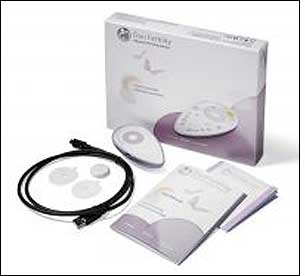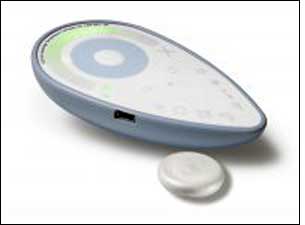Cambridge Temperature Concepts (CTC), a U.K. firm launched by a group of recent University of Cambridge graduates, has developed an RFID-based system designed to help women who are trying to get pregnant to better track and predict their ovulation cycles. The company began selling the product, called DuoFertility, last month in Europe, and hopes to begin selling it in North American in early 2010.
Ovulation causes an increase of one-half to one degree Fahrenheit in body temperature—a change that conventional glass thermometers are unable to detect. Women trying to become pregnant, therefore, have long employed specialized thermometers to track minute changes in body temperature. In order to determine ovulation, however, women must be very consistent in taking these readings on a daily basis, and they must do so as soon as they awaken in the morning.

DuoFertility is designed to make this process simpler and more accurate, explains Shamus Husheer, CTC’s CEO. The system consists of two primary parts: a small, circular waterproof module containing a basal temperature sensor and a passive 125 kHz RFID inlay, and a handheld device that contains an RFID interrogator, a USB port and indicators enabling a woman to enter additional data she might be tracking, including ovulation pain or the results of other fertility-tracking tests she might be running in tandem, such as hormone levels in her urine.
Attached to the skin just below either armpit, the module logs many thousands of temperature readings throughout the day and stores them in its 2 megabytes of memory. An adhesive pad—included with the DuoFertility kit—will hold the module in place for up to 28 days. However, the user can remove the module at any time. She may, for instance, elect to remove it before heading out of the house while wearing attire that does not conceal the module—which measures 3.5 centimeters (1.4 inches) in diameter and 7 millimeters (0.28 inch) in thickness—and then, upon returning, use a new adhesive pad to reattach.
When the woman wants to download the temperature data, she holds the handheld reader up to the module (the RF transmission will penetrate layers of clothing). Once the temperature and any additional data she inputs into the interrogator is collected, the handheld device will indicate her fertility level on that day, along with predicted levels over the following five days, based on the indicator’s color for each particular day (the darker the green light, the higher the fertility level).
The user can also plug the handheld into her computer using a provided USB cable, then download the data onto DuoFertility software to produce charts detailing her ovulation markers and fertility levels over time. She can utilize this software to produce specific charts for a doctor or fertility counselor, as well. Connecting the reader to a computer also recharges its battery.
“The key advance in our product was getting the power consumption of the sensor to below one microamp, on average,” Husheer says, because this provides a long life for the sensor. The sensor can operate for several months on its lithium battery, which can not be replaced or recharged; it uses an 8-bit microprocessor to process and compress the temperature readings, which are taken every few seconds. Up to a month’s worth of data can be stored in the module’s 2 megabytes of memory. Because it relies on a passive RFID tag to transmit the information to the reader, the module’s battery is not necessary for data transfer, and this helps extend its life.
Due to the application’s large data transfer requirements—up to 2 megabytes of data being collected from the module—Husheer says CTC could not use any existing RFID air-interface protocol that tags and readers employ to communicate with each other. Instead, he notes, the firm designed an air-interface protocol specifically for the DuoFertility application.
In addition, the data transmitted between the tag and interrogator is encrypted. “A cryptographic key exchange is done between the tag and reader at the factory,” Husheer states, “before the package is shipped.” This ensures that only the module and reader that are shipped together can be utilized together, and prevents an unauthorized third party from using a different reader to collect data from the module, or to eavesdrop on the RF transmission. If the woman damages or loses the original module, she can order a new one and then, through DuoFertility software, create a new set of cryptography keys online that will pair the replacement module with the handheld reader.
The DuoFertility kit is sold online, for £495 ($807). CTC is now working on additional RFID-based temperature sensor systems for medical applications, Husheer says. These include a take-home system designed for detecting fevers that could signify an infection in patients who have undergone outpatient surgery.


